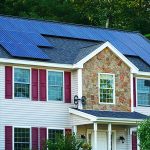Multiple unique factors go into the price of solar panels, and they are related to your electricity use and home. Here’s what to consider when calculating costs:
Solar Companies
The cost of solar panels is dependent on the solar panel company you choose. From the solar equipment system itself to installation costs and add-ons, the price will vary from company to company and the first step is to consider your options for the best solar companies.
Size, Weight and Number of Panels
When assessing solar panel cost, the size, weight and number of panels are important. For instance, when determining how many solar panels to buy, there are a few pieces of information you’ll need to know:
- How much energy your household uses
- How much space you have on your roof
- How many hours of sun your home gets and the wattage and relative efficiency of the photovoltaic (PV) solar panels you’ll be installing
Once you determine those, you can begin to calculate the cost. Divide your annual energy usage by 12 to get your monthly average in kWh. The average energy output of a typical solar panel is about 45 kWh per month. Use that number to determine how many panels you’ll need to cover your monthly usage.
You’ll need 20 to 25 panels to fully power most homes. However, that number can range anywhere from 15 to 34 panels depending on the size of the home, the efficiency of the panels and where they’re located. A solar panel installer should be able to give you an accurate estimate using your energy usage information.
Federal Solar Tax Credit
Installing solar panels earns you a federal solar tax credit. That means you’ll get credit for your income taxes, which lowers your tax bill. Congress renewed the federal tax credit so that systems installed from 2022 through 2032 can now receive a 30% tax credit.
Type of Panels
There are three main types of solar panels available for residential use: monocrystalline, polycrystalline and thin-film. The most energy-efficient and best solar panels for your home, monocrystalline solar panels, cost $1 to $1.50 per watt. Less energy-efficient, polycrystalline solar panels cost $0.90 to $1 per watt. Thin-film solar panels cost between $1 and $1.50 per watt.
Solar Panel Manufacturer
Since solar panels come in varying quality, the cost can depend highly on the solar panel’s manufacturer. Although most manufacturers generally see similar cost ranges, the better the solar panel quality, the higher the price.
Efficiency
The efficiency of solar panels is determined by the amount of sunlight reflected on the panels’ surface, which is then transformed into electrical or thermal energy. It’s also important to note that solar panels can be very efficient in colder weather which can improve energy production.
Monocrystalline solar panels are the most efficient, but their price point is high because of their complex construction. Polycrystalline solar panels are simpler to create, making them less expensive than monocrystalline ones. Thin-film PV cells are easier and less expensive to produce but are the least efficient type of solar panel.
Location
Solar panel costs also vary by state due to local quoting trends and system size differences. States have different average system sizes and incentives, causing prices to differ depending on where you live.
Roof Pitch
Your roof’s characteristics, like its pitch, will also determine solar panel cost. Typically, your solar company will charge for the difficulty of the installation, and having a complex roof will make your system cost more.
Type of Mount
Solar panels tend to come with mounting equipment that can be set up or adjusted to catch the maximum amount of sunlight. Technology has given some panels the ability to self-adjust after mounting, though this capability comes at a higher cost.
- Fixed mounts stay in place and are ideal in areas that get constant sun from all angles. They cost $10 to $15 each.
- Adjustable mounts can be shifted throughout the day for maximum efficiency. They cost $50 each.
- Tracking mounts self-track the sun for up to 45% more energy production. They can cost $500 to $3,000 each.
Type of Solar Power System
There are three types of solar power systems. Material and installation costs for each vary depending on how much equipment is needed.
- Grid-tied solar systems interact with your municipal power grid and don’t require a solar battery. This makes them the most affordable with the lowest installation cost.
- Grid-tied solar systems with storage offer a hybrid solution where panels are tied to the grid but have solar battery backups. Each battery can add $9,200 or more to your installation costs.
- Off-grid systems are the most expensive option at $45,000 to $65,000. They require high-capacity solar battery storage and a backup generator.
This post was originally published on 3rd party site mentioned in the title of this site




